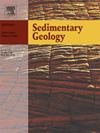High-frequency sequence patterns in lacustrine basins: Insights from delta-hyperpycnal flow systems in the Middle Jurassic shale interval, Sichuan Basin, China
IF 2.9
2区 地球科学
Q1 GEOLOGY
引用次数: 0
Abstract
Unlike marine sedimentary basins, lacustrine sedimentary basins are more sensitive to small-scale climatic changes (fourth-order and higher sequences: spanning thousands to tens of thousands of years), and exhibit characteristics such as rapid sedimentary facies transitions and strong heterogeneity. Frequent changes in the sedimentary environment significantly influence the development of sedimentary systems and the formation of sequence structures. These factors present new challenges for understanding the sequence architecture and sedimentary evolution in deep-water zones in lacustrine depression basins. Taking the Middle Jurassic Lianggaoshan Formation in the eastern Sichuan Basin, China, as an example, in this paper, we integrate data from cores, well logs, element geochemistry, and 3D seismic surveys. By applying the transgression–regression cycle theory and high-frequency sequence stratigraphy of lacustrine depression basins, we analyze the genetic mechanisms and distribution patterns of different types of sandstone interlayers within the shale interval and investigate the effect of high-frequency climatic changes on sedimentary processes in lacustrine basins. A high-frequency sequence pattern for lacustrine depression basins is established. The results indicate that within the third-order sequence of the Lianggaoshan Formation, during the shale-deposition interval (maximum water abundance period), the lacustrine depression basins were controlled by the 405 ka (fourth-order sequence) climatic cycle, which still demonstrates basin-scale expansion and contraction. In the shale interval, climate-driven lake transgression-regression cycles within fourth-order sequences promoted frequent interbedding of high sedimentation rate, coarse-grained deposits (e.g., deltaic deposits and hyperpycnal flow deposits) and low sedimentation rate, fine-grained deposits (e.g., suspension settling: shallow-water mudstone and deep-water shale). This reveals a high-frequency sequence stratigraphy pattern that demonstrates the coupling mechanism between the sedimentary processes and climatic forcing in lacustrine depression basins. Within the fourth-order sequences, the early transgressive systems tract and late regressive systems tract are characterized by shallow water and arid conditions, which resulted in the development of organic-poor mudstones, while deltaic sandstones prograde into the center of the basin. In contrast, the late transgressive systems tract and early regressive systems tract are marked by deep water and humid conditions, which led to the formation of organic-rich shales, accompanied by hyperpycnal flow sandstones entering the center of the basin. This resulted in the formation of multiple sets of strongly heterogeneous interbedded organic-poor mudstone and organic-rich shale assemblages. The findings establish a high-frequency sequence pattern for these basins, elucidate their internal depositional and facies evolution processes, and provide scientific guidance for predicting sweet spot intervals in lacustrine shale oil and gas reservoirs.
湖盆高频层序模式:来自四川盆地中侏罗统页岩段三角洲-高旋流体系的启示
与海相沉积盆地不同,湖相沉积盆地对小尺度气候变化更为敏感(四阶及更高层序:跨越数千年至数万年),具有沉积相转变迅速、非均质性强等特点。沉积环境的频繁变化对沉积体系的发育和层序构造的形成具有重要影响。这些因素对认识湖陷盆地深水带层序构型和沉积演化提出了新的挑战。本文以四川盆地东部中侏罗统凉高山组为例,综合利用岩心、测井、元素地球化学和三维地震等资料。应用海退旋回理论和湖盆高频层序地层学,分析了页岩层段内不同类型砂岩夹层的成因机制和分布模式,探讨了高频气候变化对湖盆沉积过程的影响。建立了湖相坳陷盆地的高频层序模式。结果表明:在梁高山组三阶层序内,在页岩—沉积期(最大丰水期),湖坳陷盆地受405 ka(四阶层序)气候循环控制,仍表现出盆地尺度的扩张与收缩;在页岩层段,四阶层序内气候驱动的湖泊海侵回旋回促进了高沉积速率、粗粒沉积(如三角洲沉积和超旋流沉积)与低沉积速率、细粒沉积(如悬浮沉积:浅水泥岩和深水页岩)的频繁互层。揭示了湖坳陷盆地沉积过程与气候强迫耦合机制的高频层序地层学模式。在四阶层序中,早海侵体系域和晚海退体系域以浅水干旱为特征,发育贫有机质泥岩,三角洲砂岩向盆地中心推进。而晚海侵体系域和早退体系域则以深水湿润条件为标志,形成富有机质页岩,并伴有超旋流砂岩进入盆地中心。形成多套非均质互层的贫有机质泥岩和富有机质页岩组合。研究结果建立了这些盆地的高频层序模式,阐明了其内部沉积相演化过程,为湖相页岩油气储层甜点层段预测提供了科学指导。
本文章由计算机程序翻译,如有差异,请以英文原文为准。
求助全文
约1分钟内获得全文
求助全文
来源期刊

Sedimentary Geology
地学-地质学
CiteScore
5.10
自引率
7.10%
发文量
133
审稿时长
32 days
期刊介绍:
Sedimentary Geology is a journal that rapidly publishes high quality, original research and review papers that cover all aspects of sediments and sedimentary rocks at all spatial and temporal scales. Submitted papers must make a significant contribution to the field of study and must place the research in a broad context, so that it is of interest to the diverse, international readership of the journal. Papers that are largely descriptive in nature, of limited scope or local geographical significance, or based on limited data will not be considered for publication.
 求助内容:
求助内容: 应助结果提醒方式:
应助结果提醒方式:


